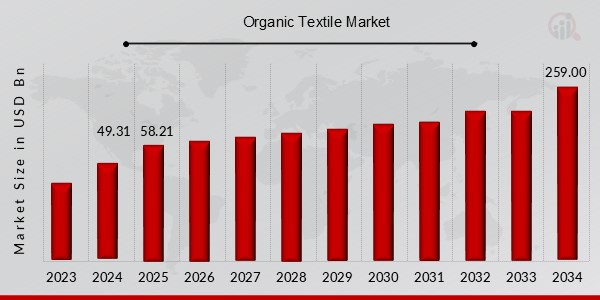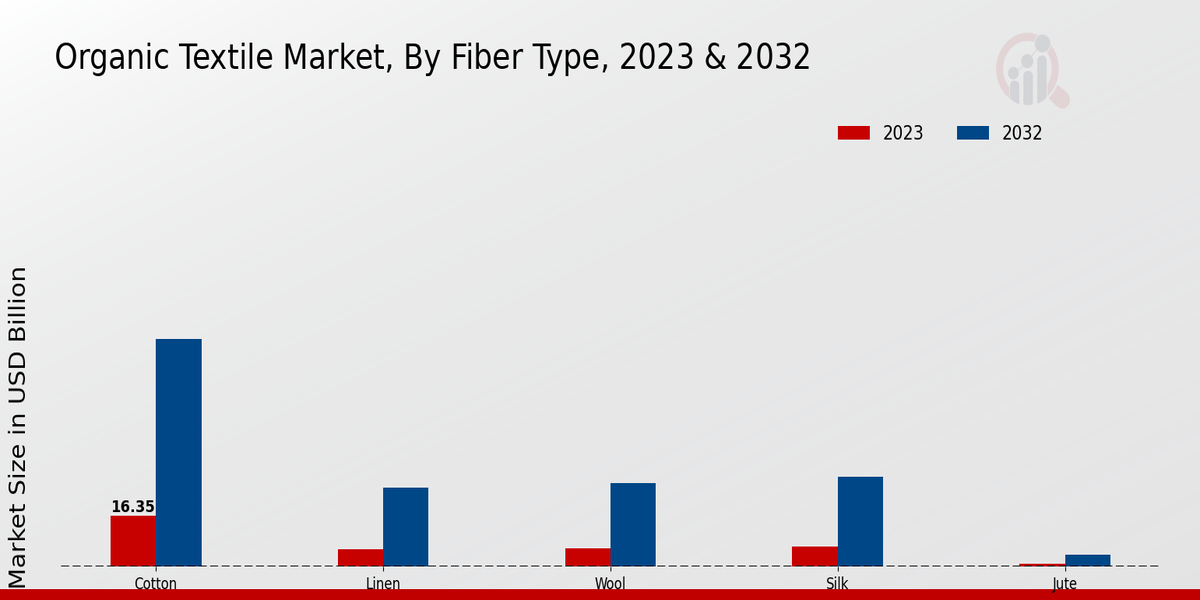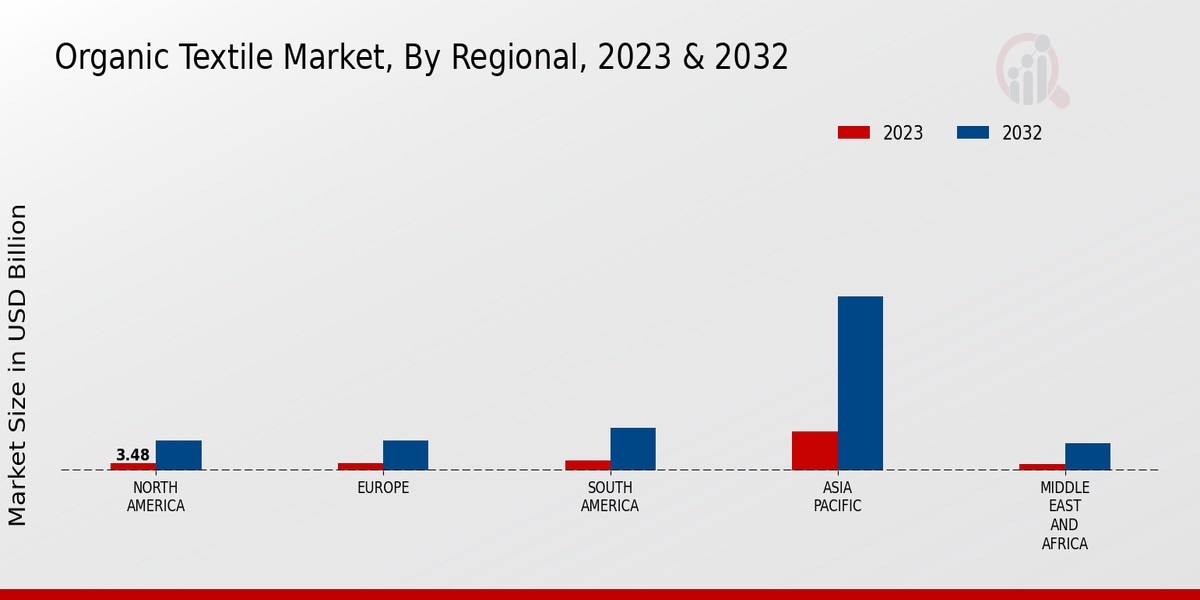Global Organic Textile Market Overview
The Organic Textile Market Size was estimated at 49.31 (USD Billion) in 2024. The Organic Textile Industry is expected to grow from 58.21 (USD Billion) in 2025 to 259.00 (USD Billion) by 2034. The Organic Textile Market CAGR (growth rate) is expected to be around 18.04% during the forecast period (2025 - 2034).
Key Organic Textile Market Trends Highlighted
The demand for organic textiles is on the rise due to increased consumer consciousness about environmental friendliness and ethical sourcing. Some of the major drivers are the rise of eco-friendly fashion, an increase in environmental awareness, and regulations that promote sustainability. There are opportunities to develop new types of organic fibers, expand organic farming, and adopt a circular fashion approach. Recent developments have seen luxury fashion houses using organic fabrics, online platforms becoming available to buyers who want organic products, and sustainable certification labels appearing.
Businesses should be aware of these developments if they intend to make profits from the growing market for eco-friendly cloth materials.

Source: Primary Research, Secondary Research, Market Research Future Database and Analyst Review
Organic Textile Market Drivers
-
Rising Consumer Awareness and Demand for Sustainable Products
There is an increasing consciousness among consumers about how their purchasing decisions impact the environment and society. This has resulted in a change towards sustainable goods such as organic textiles. Organic textiles are made from natural fibers that are cultivated without the application of any poisonous pesticides or chemicals that may be harmful to the body. They are equally produced with minimal ecological footprints. For this reason, the demand for organic textiles has been on a steady increase due to increasing consumer awareness.
Government Regulations and Support
Also, government regulations and support have been integral in boosting the growth of the organic textile industry. Some countries have imposed policies that require the use of organic textiles in some goods, such as baby clothes and linen. Moreover, many governments are giving financial benefits to enterprises that make or employ organics in their businesses.
Technological Advancements
This market is also being pushed by technological advances in organic textiles. New technologies are being developed that make producing organic textiles easier and more efficient. For instance, there are new ways of dying and finishing organic textiles which reduce the use of harmful chemicals.
Organic Textile Market Segment Insights
Organic Textile Market Fiber Type Insights
The Organic Textile Market is segmented based on fiber type into cotton, linen, wool, silk, and jute. The cotton segment held the largest market share in 2023 and is expected to continue its dominance over the forecast period. The increasing demand for organic cotton in the textile industry is primarily due to its sustainability, comfort, and breathability. The linen segment is projected to witness significant growth over the forecast period, owing to its eco-friendly nature, durability, and moisture-wicking properties.
The growing popularity of linen in the fashion industry is further fueling the growth of this segment.The wool segment is expected to grow steadily over the forecast period. Wool is a natural fiber known for its warmth, insulation, and moisture-repellent properties. The increasing demand for organic wool in the production of high-quality textiles is driving the growth of this segment. The silk segment is anticipated to experience moderate growth over the forecast period. Silk is a luxurious fiber known for its smoothness, drape, and luster.
The growing demand for organic silk in the luxury fashion industry is expected to drive the growth of this segment.The jute segment is projected to grow at a steady pace over the forecast period. Jute is a natural fiber known for its strength, durability, and eco-friendliness. The increasing demand for organic jute in the production of sustainable packaging and home décor products is driving the growth of this segment. Overall, the Organic Textile Market is expected to witness significant growth over the forecast period, driven by the increasing consumer preference for sustainable and eco-friendly products.
The rising demand for organic textiles in various end-use industries, including fashion, home furnishings, and medical applications, is expected to fuel the market growth.

Source: Primary Research, Secondary Research, Market Research Future Database and Analyst Review
Organic Textile Market Product Type Insights
The Organic Textile Market segmentation by product type comprises apparel, home textiles, industrial textiles, and medical textiles. The apparel segment held the largest market share of 46.9% in 2023 and is projected to continue its dominance throughout the forecast period. Rising consumer demand for sustainable and eco-friendly fashion has fueled the growth of the organic apparel market.
The home textiles segment is anticipated to showcase a remarkable growth rate of 19.5% during the forecast period, driven by increasing consumer preference for organic home décor products.Industrial textiles, used in various industries such as automotive, construction, and healthcare, are expected to witness steady growth due to their durability and environmental benefits. Medical textiles utilized in healthcare settings are poised to grow significantly due to the increasing emphasis on patient safety and hygiene.
Organic Textile Market Certification Standard Insights
The Organic Textile Market is segmented into various certification standards, including the Organic Textile Standard (GOTS), Organic Content Standard (OCS), Textile Exchange Organic Cotton Standard (OCS), European Union Organic Textile Standard (EUTS), and National Organic Program (NOP). GOTS enjoys a large market share because of its rigid environmental and social criteria. The GOTS-certified organic textile market was valued at about USD 10.2 bn in 2023, and it is anticipated to reach USD 29.4 bn by 2032, rising at a CAGR of 12.5%.
For instance, OCS and OCS Blended certifications mainly examine the organic content of textiles, while EUTS and NOP deal with regional organic textile standards in Europe and America correspondingly. It is the increasing consumer demand for sustainable as well as eco-friendly textiles that is driving growth in the organic textile market, and certification standards are crucial in guaranteeing the credibility plus legitimacy of organic products.
Organic Textile Market Distribution Channel Insights
In the case of the Organic Textile Market, the distribution channel section is a key element in linking producers to buyers. The market is divided into four major channels of distribution: Online: This has gained significant momentum in terms of growth over the last few years because e-commerce platforms have emerged. In 2023, online accounted for about 30% of total sales of the Organic Textile Market. It comes with convenience, variety, and competitive costs. Some of the biggest players here include Amazon, Etsy, and Zalando.
Offline (Retail Stores): Traditional brick-and-mortar retail stores are also important channels for organic textiles. They held a market share of approximately 45% in 2023. These outlets give consumers an opportunity to physically touch and feel products before actualizing their purchase intentions. Among others, Walmart, Target, and H have become leading establishments in this category. Direct-to-Consumer: This channel involves manufacturers selling directly to consumers through their own websites or pop-up shops, which allows them to bypass intermediaries and have more control over branding as well as customer relationships.
The Internet was responsible for about 15% of market revenue coming from direct-to-consumer channels in 2023 through brands like Patagonia or Everlane, which have successfully embraced this model. Business-to-Business: In this distribution channel, businesses sell it to other businesses, such as clothing manufacturers or home textile makers, among others. B2B accounted for nearly10%of all market share by 2023. It is driven by increasing demand for sustainability and ethical sourcing materials across different industries
Organic Textile Market End-Use Application Insights
Organic Textile Market Segmentation by End-Use Application Fashion, Home Furnishings, Healthcare, and Industrial Industries: The fashion segment had the leading market share in 2023 with more than 60% of Organic Textile Market revenue. The sector is growing due to increasing demand for eco-friendly and sustainable fashion products. Organic home textiles like curtains, bedding, and upholstery, among others, are expected to drive growth in the Home Furnishing segment over the forecast period.
For instance, they are hypoallergenic, which means they cannot cause any allergic reaction to anyone who comes into contact with these fabrics; furthermore, their moisture-wicking properties help keep your body dry even during hot weather conditions. It was carefully forecasted that the industrial portion would demonstrate a moderate rise as this sector has already started utilizing natural materials, including wool, cotton, and flax, for the protection of clothes' insulation materials that are otherwise used for other purposes like filtration.
Organic Textile Market Regional Insights
The Organic Textile Market is experiencing significant growth, and the regional segmentation offers insights into the market dynamics. North America holds a dominant position in the market, accounting for over 40% of the revenue in 2023. The region's high disposable income, growing awareness about sustainability, and stringent regulations drive this growth. Europe follows closely, with a market share of approximately 30%, driven by eco-conscious consumers and government initiatives promoting organic textiles.
APAC is projected to witness the fastest growth during the forecast period, owing to rising consumer demand for eco-friendly products.South America and MEA are emerging markets with potential for growth, supported by increasing urbanization and growing middle-class populations.

Source: Primary Research, Secondary Research, Market Research Future Database and Analyst Review
Organic Textile Market Key Players And Competitive Insights
Major players in the Organic Textile Market industry are constantly striving to gain a competitive edge by introducing innovative products and expanding their reach. Leading Organic Textile Market players are investing heavily in research and development to create sustainable and eco-friendly textiles. The development of the organic textile market is driven by consumer demand for natural, organic, and environmentally friendly products.
The Organic Textile Market Competitive Landscape is expected to remain competitive in the coming years, with key players focusing on product innovation, strategic partnerships, and market expansion.Patagonia, a leading outdoor apparel and gear brand, is committed to sustainability and uses organic cotton, recycled materials, and fair trade practices. The company has a strong brand reputation for its high-quality products and ethical practices. Another key player, Eileen Fisher, focuses on creating sustainable and stylish clothing made from organic and recycled materials.
The company's commitment to environmental responsibility and social justice has earned it a loyal customer base.Another competitor, Reformation, is known for its sustainable fashion and uses eco-friendly materials such as organic cotton, Tencel, and deadstock fabrics. The company's unique designs and ethical production practices have made it a popular choice among environmentally conscious consumers. These companies are just a few examples of the many players shaping the Organic Textile Market landscape. The industry is expected to witness continued growth and innovation, driven by consumer demand for sustainable and eco-friendly products.
Key Companies in the Organic Textile Market Include
Organic Textile Market Industry Developments
The organic textile market is projected to reach USD 259.00 billion by 2034, exhibiting a CAGR of 18.04% during the forecast period (2025-2034). Growing consumer awareness about sustainability, ethical consumption, and the environmental impact of conventional textiles drives market expansion. Additionally, rising disposable income in emerging economies and increasing demand for organic products, particularly in the fashion and home textiles sectors, contribute to market growth. Recent developments include partnerships between organic textile manufacturers and fashion brands, such as HM and Patagonia, to promote sustainable practices and meet consumer demand.
Furthermore, government initiatives and regulations supporting the adoption of organic textiles are providing a favorable market landscape.
Organic Textile Market Segmentation Insights
Organic Textile Market Fiber Type Outlook
Organic Textile Market Product Type Outlook
Organic Textile Market Certification Standard Outlook
- Organic Textile Standard (GOTS)
- Organic Content Standard (OCS)
- Textile Exchange Organic Cotton Standard (OCS)
- European Union Organic Textile Standard (EUTS)
- National Organic Program (NOP)
Organic Textile Market Distribution Channel Outlook
Organic Textile Market End-Use Application Outlook
Organic Textile Market Regional Outlook
| Report Attribute/Metric |
Details |
| Market Size 2024 |
49.31 (USD Billion) |
| Market Size 2025 |
58.21 (USD Billion) |
| Market Size 2034 |
259.00 (USD Billion) |
| Compound Annual Growth Rate (CAGR) |
18.04% (2025 - 2034) |
| Report Coverage |
Revenue Forecast, Competitive Landscape, Growth Factors, and Trends |
| Base Year |
2024 |
| Market Forecast Period |
2025 - 2034 |
| Historical Data |
2020 - 2024 |
| Market Forecast Units |
USD Billion |
| Key Companies Profiled |
Texollini, Eileen Fisher, Continental Clothing Co., SKNL Basics, Pact, Thought, Coyuchi, Fair Indigo, Veja, Patagonia, Organic Basics, Komodo, Synergy Organics, Reformation, Kotn |
| Segments Covered |
Fiber Type, Product Type, Certification Standard, Distribution Channel, End-Use Application, Regional |
| Key Market Opportunities |
1 Growing demand for sustainable fashion2 Increasing awareness of environmental impact3 Expansion of organic textile production4 Technological advancements in organic textile manufacturing5 Government initiatives promoting organic textile adoption |
| Key Market Dynamics |
Growing Consumer Awareness Increasing Demand for Sustainable Fashion Technological Advancements Government Initiatives Rising Concerns over Environmental Impact |
| Countries Covered |
North America, Europe, APAC, South America, MEA |
Frequently Asked Questions (FAQ):
The organic textile market is expected to reach USD 58.21 billion in 2025 and is projected to grow at a CAGR of 18.04% from 2025 to 2034, reaching a value of USD 259.00 billion by 2034.
North America held the largest share of the organic textile market in 2022, accounting for the highest market value.
Organic textiles are used in a wide range of applications, including clothing, home textiles, and industrial products. Organic cotton is the most commonly used organic textile fiber, and it is used in a variety of clothing items, such as t-shirts, jeans, and dresses. Organic home textiles include bedding, towels, and curtains. Industrial organic textiles are used in a variety of products, such as medical supplies, filters, and wipes.
Key competitors in the organic textile market include Patagonia, Eileen Fisher, and Reformation. These companies are known for their commitment to sustainability and ethical sourcing practices.
The growth of the organic textile market is being driven by several factors, including rising consumer demand for sustainable products, increasing awareness of the environmental and health benefits of organic textiles, and government regulations promoting the use of organic materials.
The organic textile market faces several challenges, including the high cost of organic production, the limited availability of organic fibers, and the lack of consumer awareness about the benefits of organic textiles.
Key trends in the organic textile market include the growing popularity of organic cotton, the increasing use of organic textiles in home furnishings, and the development of new organic textile technologies.
The future outlook for the organic textile market is positive. The market is expected to continue to grow in the coming years, driven by rising consumer demand for sustainable products and increasing awareness of the environmental and health benefits of organic textiles.
Key opportunities in the organic textile market include the development of new organic textile products, the expansion of organic textile production into new markets, and the development of new technologies to improve the sustainability of organic textile production.
Key challenges in the organic textile market include the high cost of organic production, the limited availability of organic fibers, and the lack of consumer awareness about the benefits of organic textiles.
















